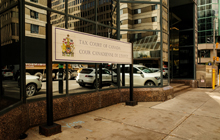How to legitimately defer the worst of Canada's departure tax when becoming a non-resident and moving to another country

The departure tax can create a substantial and unforeseen tax bill for the unaware emigrating taxpayer explains tax lawyer and accountant David J. Rotfleisch
The Canadian Departure Tax Regime
 |
David J Rotfleisch, CPA, JD is the founding tax lawyer of Taxpage.com and Rotfleisch & Samulovitch P.C., a Toronto-based boutique tax law corporate law firm. |
Under subsection 128.1(4) of the Canadian Income Tax Act, a Canadian emigrating to another jurisdiction is subject to a "deemed disposition" on qualifying property. (This deemed disposition is often referred to as Canada's "departure tax"). Where a taxpayer is subject to departure tax, that taxpayer is deemed to have sold and repurchased qualifying property at its fair market value immediately before becoming a non-resident of Canada.
Thus, any gain that has accrued on that property prior to becoming a non-resident is recognized for tax purposes, even though the taxpayer has not actually disposed of any property. This is referred to as a "deemed disposition." In essence, the departure tax is the Canadian tax system's method of asserting its jurisdiction to tax the accrued value of a taxpayer's property while that taxpayer was resident in Canada.
The departure tax can create a substantial and unforeseen tax bill for the unaware emigrating taxpayer. And while tax planning services from an expert Canadian tax lawyer can help to mitigate the overall impact of departure tax on a taxpayer's finances, a Canadian emigrant will inevitably have to fund some departure tax. The Canadian tax system provides limited taxpayer relief under subsection 220(4.5) of the Income Tax Act by allowing qualifying taxpayers to post security in lieu of paying the total amount of departure tax owing when emigrating from Canada.
What will qualify as adequate security, however, will depend on the circumstances. As well, there is a very specific process which must be observed for electing under subsection 220(4.5) by filing Form T1244 with the Canada Revenue Agency ("CRA"). This article will begin by briefly exploring the rules concerning tax residence in Canada and the conditions under which somebody can emigrate from Canada for tax purposes. It will then discuss the particulars of subsection 220(4.5), and in particular, who can make an election under the subsection, what will qualify as adequate security, and how the election must be made.
A Brief Summary of Residence Rules for Canadian Tax Law Purposes
To understand how the Canadian departure tax works, it is necessary to understand the concept of residence for tax purposes. Under subsection 2(1) of the Canadian Income Tax Act, an individual who is a resident of Canada is subject to tax on worldwide income. In contrast, a non-resident individual of Canada is only subject to tax on Canadian-source income under subsection 2(3) and Part XIII of the Income Tax Act. Residence for tax purposes can be distinguished from citizenship or nationality in that it is not an administrative status determined by the Canadian government. Rather, residence for tax purposes follows very particular rules under the Income Tax Act and Canadian common law.
For purposes of Canada's domestic tax laws, an individual can be found resident in Canada:
- where that taxpayer is "ordinarily resident" within the meaning of subsection 250(3) of the Income Tax Act; or
- where that taxpayer is not otherwise ordinarily resident in Canada at any point in a given taxation year, that taxpayer is a "deemed resident" under paragraph 250(1)(a) of the Income Tax Act.
Defining "Ordinarily Resident" in Canada
Under subsection 250(3) of the Income Tax Act, an individual is viewed as a resident of Canada where that individual is "ordinarily resident" in Canada. ("Ordinary residence" is often referred to as "factual residence.") The Income Tax Act does not define what it means to be "ordinarily resident," and so Canadian courts have articulated conditions that are to be weighed when determining whether a person is ordinarily resident or not. Broadly speaking, a person's ordinary residence is "the place where in the settled routine of his life he [or she] regularly, normally or customarily lives." Other relevant factors for determining somebody's ordinary residence include a person's:
- past and present habits of life;
- regularity and length of visits in the jurisdiction asserting residence;
- ties within that jurisdiction;
- ties elsewhere;
- permanence or otherwise of purposes of stay abroad.
In addition, the CRA has published its own views in Income Tax Folio S5-F1-C1 ("Determining an Individual's Residence Status") as to what factors will militate in favour of an individual being a Canadian factual resident. While the CRA's published views on Canadian tax law do not have force of law in Canada, they have been recognized by Canadian courts as fundamental tools for the interpretation and application of Canada's tax laws to other taxpayers. Those views should not be ignored when they correctly interpret the law, and in particular, CRA's Income Tax Folio S5-F1-C1 has been cited with approval by the Tax Court of Canada and reasonably tracks applicable case law concerning Canadian tax residency.
Broadly speaking, when considering both the common law and CRA's published views, the most significant factors for establishing whether an individual is a Canadian factual resident will include:
- whether that individual has a "dwelling place" (i.e. a home or apartment) available for their long-term use in Canada;
- whether that individual has a spouse or common-law partner in Canada; and
- whether that individual has any dependents in Canada.
Other important secondary ties that can influence a finding that an individual is a Canadian factual resident or not include that individual's personal property (i.e. furniture and vehicles), economic ties (i.e. bank accounts, investments, registered plans, credit cards and other debt), immigration status, government documents (i.e. health insurance, driver's licence, passport), and social ties (i.e. memberships to professional organizations or unions, or recreational clubs or religious organizations) in Canada.
It bears repeating that an individual's factual residence remains a purely fact-specific determination. Canadian courts have, in certain circumstances, found a taxpayer to be a non-resident of Canada or to have ceased to be a factual resident in Canada, despite maintaining significant ties (i.e. a dwelling, spouse, or dependents) in Canada.
The "Deemed Residence" Rule
Paragraph 250(1)(a) of the Income Tax Act deems an individual to be a resident of Canada throughout a particular tax year if that person "sojourned" in Canada for 183 days or more in that year. This is often referred to as the "deemed residence" rule. The meaning of "sojourning" has been broadly interpreted to mean that the individual was "temporarily resident" in Canada. A commuter can be distinguished from a sojourner in that a commuter is only present in Canada for purposes of travelling between destinations, like to and from work. A sojourner may stay in Canada, even casually or intermittently, but with some sense of permanence. Whether an individual is a sojourner is a fact-specific analysis similar to the factual residence test.
It is worth acknowledging that an individual can only be deemed resident in Canada where that individual was not otherwise a factual resident of Canada, and so the factual residence test must be considered before the deemed residence rule when determining an individual's status as a Canadian tax resident.
Ceasing to be a Resident of Canada for Tax Purposes
An individual may be viewed as a factual non-resident where that individual's ties to Canada are minimal and demonstrate that Canada is not that individual's settled, normal or customary place of living. For a Canadian factual resident to become a non-resident, that taxpayer will have to break enough significant residence ties to Canada such that there is no longer a basis for Canada to assert its tax jurisdiction over that individual. As well, where a taxpayer sojourn in Canada for fewer than 183 days, the deemed residence rule will simply not apply. Breaking Canadian tax residence under the domestic Canadian tax regime can prove quite difficult without appropriate tax planning services. A Canadian tax resident must sever enough significant ties to Canada in a given tax year and must also avoid returning to Canada to avoid being caught by the deemed residence rule.
Further, an individual may be deemed to be a non-resident under subsection 250(5) of the Income Tax Act in very specific circumstances. Canada has formed a number of bilateral tax treaties with countries worldwide, which contain provisions to help settle what countries' domestic tax laws will have claim to tax that individual, where that individual is a tax resident of both countries. Most Canadian treaties follow the OECD Model Tax Convention, which provides a number of standard and sequential tie-breaker rules to determine where an individual is a resident. Under the OECD Model, an individual is deemed to be a resident in the jurisdiction:
- in which the individual has a permanent home available;
- in the jurisdiction of that individual's "centre of vital interest";
- in the jurisdiction of that individual's "habitual abode";
- in the jurisdiction that individual is a citizen or national; or
- where the above tests remain inconclusive, whatever mutual conclusion that the competent authorities of each jurisdiction arrive at (that is, the Canada Revenue Agency and the other country's tax authority will come to an agreement on the issue.)
To give effect to an international treaty determination, under subsection 250(5) of the Income Tax Act, where a Canadian tax resident is deemed a resident of another country under a bilateral tax treaty, then that individual is deemed to be a non-resident of Canada as of that day the treaty applied. In other words, the deemed non-residence rule will only apply where an individual is resident in both Canada and another country and is not deemed a Canadian tax resident under that treaty. Thus, where a Canadian tax resident is otherwise deemed to be a Canadian tax resident under a bilateral tax treaty, that individual's status as a Canadian tax resident will remain untouched.
Subsection 220(4.5) and Delaying Departure Tax
As discussed above, when an individual who was a Canadian tax resident becomes a non-resident, then that person will be subject to departure tax on qualifying property. A natural person who becomes a non-resident would be required to file a Form T1161 with that year's tax return, listing all properties owned at the time of emigration if the fair-market-value of those properties exceeded $25,000 (subject to limited exceptions including cash and personal-use property with a fair-market-value of less than $10,000). A taxpayer must also prepare and submit Form T1243 with that year's tax return to report the property subject to departure tax in that year.
Under subsection 220(4.5), a "qualifying Canadian taxpayer" (which includes a natural person or a trust) may elect with the CRA to post adequate security in lieu of paying that departure tax. The election under subsection 220(4.5) is only available for a tax that results from the deemed disposition of qualifying property immediately before emigration and not any other tax payable for the year, like income tax payable on income earned from an office or employment or a personal business run while resident in Canada. In order to make that election, the taxpayer must file a completed Form T1244 ("Election, under Subsection 220(4.5) of the Income Tax Act, to Defer the Payment of Tax on Income Relating to the Deemed Disposition of Property") with the CRA on or before the balance due date for taxes owing for the year of emigration. Extending that deadline is subject to the CRA's discretion and may not be granted in all cases.
Under subsection 220(4.51) of the Income Tax Act, adequate security will not be required for the first $16,500 of federal departure tax owing. For any remaining tax, the relevant security must be posted by the filing due date of the year following emigration. If security is not posted, penalties and interest will accrue on the tax due. If adequate security is posted, the departure tax is treated as paid, and interest will not accrue.
What qualifies as "adequate security" for the purposes of subsection 220(4.5) is based on the actual amount of departure tax owing. Broadly speaking, the Income Tax Act provides that security must be of an amount that is at least equal to the federal and provincial taxes owing as a result of the departure tax. The CRA has discretion as to what form of security will be acceptable for an election under subsection 220(4.5), but it will generally accept:
- a letter of guarantee or a letter of credit issued by a Canadian financial institution;
- shares in a Canadian private company, to the extent that those shares are the property giving rise to departure tax; and
- a mortgage on Canadian real property, up to 75% of the appraised equity of the property.
A taxpayer may be motivated to make an election under subsection 220(4.5) for a number of reasons. First, as discussed above, the departure tax can be quite substantial and can disrupt cash flows for a business or the lifestyle of a taxpayer. Posting security provides additional time for a taxpayer to organize personal and business affairs to account for a sudden increase in taxes, where that taxpayer has not actually received any proceeds from disposing of property. Second, a taxpayer may wish to return to Canada sometime in the near future and take advantage of the unwinding rules under the Income Tax Act.
Under subsection 128.1(6), where a taxpayer emigrant of Canada returns to Canada, that taxpayer may elect to claim back some or all of the departure tax previously paid or payable (as long as those assets subject to departure tax are still owned by the taxpayer). The election does not cancel the deemed disposition itself, but it reduces the deemed proceeds by an amount that equals the least of the following three amounts: (1) the amount of the gain reported on the taxpayer's tax return in the tax year in which the taxpayer emigrated (i.e., the deemed disposition that would otherwise result); (2) the fair market value of the asset on the date the taxpayer returns to Canada; and (3) an amount that the taxpayer designates.
If a taxpayer anticipates a return to Canada, then that taxpayer can elect under subsection 220(4.5) to defer departure tax and elect again under 128.1(6) when returning to Canada to substantially reduce the deemed proceeds received. In that way, a taxpayer can effectively avoid having to remit the full departure taxes owing as a result of emigrating to Canada, only to have some or all of those taxes refunded to the taxpayer.
It should be clear from the above that the process to post adequate security for departure taxes can take a substantial amount of time to complete and to obtain approval from the CRA. Starting the process early is crucial to ensure sufficient time to obtain CRA's approval for proposed security before the applicable tax filing deadline. It warrants discussing your goals and options with an expert Canadian tax lawyer to determine exactly how to go about planning your departure from Canada so that you can avoid the full weight of Canada's departure tax regime.
David J Rotfleisch, CPA, JD is the founding tax lawyer of Taxpage.com and Rotfleisch & Samulovitch P.C., a Toronto-based boutique tax law corporate law firm and is a Certified Specialist in Taxation Law who has completed the CICA in-depth tax planning course. He appears regularly in print, radio and TV and blogs extensively.
With over 30 years of experience as both a lawyer and chartered professional accountant, he has helped start-up businesses, cryptocurrency traders, resident and non-resident business owners and corporations with their tax planning, with will and estate planning, voluntary disclosures and tax dispute resolution including tax audit representation and tax litigation. Visit www.Taxpage.com and email David at david@taxpage.com.
Read the original article with links. Title image: iStock. Author photo courtesy Rotfleisch & Samulovitch P.C.






(0) Comments